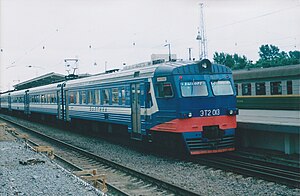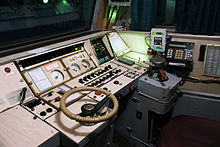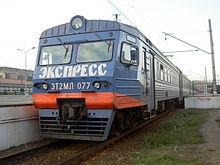RŽD series ЭТ2
| RŽD series ЭT2 (ET2) | |
|---|---|
|
ET2-013
|
|
| Numbering: | different numbering according to the modifications |
| Number: | ЭТ2: 30 ЭТ2М: 116 ЭТ2А: 1 Number of wagons in unit: 4,6,8,10,12 |
| Manufacturer: | Torzhok wagon factory |
| Year of construction (s): | 1993-2010 |
| Gauge : | 1,520 mm |
| Length over coupling: | (1 wagon) ЭТ2, ЭТ2А: 19,600 mm ЭТ2М: 20,156 mm |
| Height: | 4,253 mm |
| Width: | 3,522 mm |
| Bogie axle base: | Motor car: 2,600 mm Sidecar: 2,400 mm |
| Service mass: | Empty weight ЭТ2М: control car: 51.7 t sidecar: 42.8 t motor car: 60 t 10-wagon unit: 518.6 t empty weight ЭТ2A: control car: 45 t sidecar: 42.5 t motor car: 60.6 t empty weight 10 -Wagon unit: 529 t |
| Top speed: | 130 km / h |
| Hourly output : | ЭТ2М: 235 kW (1 car) |
| Acceleration: | ЭТ2, ЭТ2М: 0.62 m / s 2 ЭТ2А: 0.8 m / s 2 |
| Braking delay: | ЭТ2, ЭТ2М: 0.65 m / s 2 ЭТ2А: 0.8 m / s 2 |
| Wheel diameter: | Motor car: 1,050 mm Sidecar: 950 mm |
| Power system : | 3 kV DC voltage |
| Power transmission: | Overhead line |
| Number of traction motors: | 4 (motor vehicle) |
| Brake: |
Compressed air brake Recuperation brake |
| Seats: | ЭТ2A: Control cars: 74 Motor cars: 104 Sidecars: 100 Total number of 10-wagon units: approx. 970 |
| Classes : | 1st / 2nd / 3rd |
The ЭТ2 (ET2) is a multiple unit of the Rossijskije schelesnyje dorogi built by the Torzhok wagon factory , which is used specifically in suburban traffic. It belongs to a series of electric multiple units for direct current drive with recuperation brake . It was produced with several modifications in a total of 147 electric trains. The factory designation of the original version is 62-4160 .
Modifications
Briefly about the modifications
For a better understanding, the abbreviations mean for the modifications:
- M modernized
- L luxury cabin (superior comfort)
- E energy storage variant
Original variant of the ЭТ2
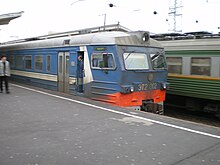
The vehicles belong to a series of on-site electric trains, they were delivered from 1993 to 1998 in a total of 30 units. Two of them, the ЭТ2.002 and the ЭТ2.013, are currently in service as express trains on the Moscow - Tver , Tver - Torzhok and Konakovo - Moscow sections .
ЭТ2Л
This is a version of the ЭТ2 for high comfort. It was built in 1999 as a 6-car unit with the designation ЭТ2.027 in one copy. From 2005 he was nicknamed Гудок ( Gudok, German "horn"). In 2011 it was colored in the corporate colors of RŽD . It was operated as an express train on the October Railway on the Saint Petersburg - Veliky Novgorod section . In the current time of Expreßzugverkehr is primarily with the vehicles of the series on this line ЭД4 (September 2011 - August 2012), ЭТ2M - and (March 2013 September 2012) ЭС1 served (March 2013 to the present day). The multiple unit was given to the motor vehicle depot in Saint Petersburg's Finnish station at the present time . Inside two of the cars, instead of the comfortable seats, plastic seats with an orange color as in the ЭТ2M were used. The window frames and luggage racks on them were also discovered in blue. The train was operated as both a 6-car and an 8-car unit. In the latter case, vehicles of the ЭТ2M series were used.
ЭТ2M
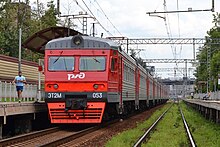
These vehicles are part of a series of electric trains for direct current that were manufactured from 1999 to 2010 on the basis of the ElektroТ2 electric trains in the Torzhok wagon factory. The factory name is 62-4160 M . The factory designation for the motor vehicles was 62-4162M, the sidecar 62-4163M, and the control vehicle 62-4161M .
Full description
The first electric train ЭТ2M with the designation ЭТ2M.028 was built in August 1999, and it was received by the Sverdlovsk depot of the railway company of the same name. Externally, the vehicles do not differ from the railcars of the original version. Several minor changes occurred during the delivery period of the electric trains.
- The front section was swapped from No. 029 for the first time, from No. 030 to No. 036 for the second time, from No. 037 to No. 057 for the third time, from No. 060 to last time.
- the screen above the headlights was not available for inventory numbers 029 to 032 .
- in the case of two electric multiple units (inventory numbers 029 and 030 ) the construction of the roof over the driver's cab was changed.
- The latest design plastic seats changed their color three times: from inventory numbers 028 to 072 they were orange, from inventory numbers 047 and from inventory numbers 073 to 135 they were blue, from inventory numbers 136 to 143 they were white with a fabric cover Double blue; once blue with dark blue rectangles, and once blue with dark blue dots.
- the shape of the lighting for illuminating the passenger compartment has been changed; From inventory numbers 028 to 086 , normal incandescent lamps were used, lamps with daylight lighting were used on inventory numbers 087 to 135 , and the vehicles with inventory numbers 136 to 143 were illuminated with light-emitting diodes .
- the light source for the headlights / stoplight was changed from incandescent lamps to light-emitting diodes from inventory number 130 on;
- A new arrangement of the doors with corridors into the service room could be observed from the vehicles with inventory number 090 .
- a modified control panel for the train driver with the designation 4161МЛ.07.15.000-1 from local production was placed in the driver's cabs of the vehicles with the inventory numbers 092 to 143 . The vehicles with inventory numbers 140 to 143 used a joystick to operate the drive switch . In addition, the arrangement of the vigilance handle has been changed, the box for the documentation has been removed. Up to inventory number 0092 , the old version of the desk, analogous to the ЭТ2 , had been used.
- The electronic route display was set up from inventory number 094 to inventory number 143 .
Electric traction motors ТЭД-2U1 (TED-2U1) and ЭК-235У1 (EK-235U1) were used on the ЭТ2M electric train . The mass of the complete 10-car train increased to 518.6 t compared to the 506 t in the original version. In addition, with this modernized variant, there was the possibility of forming trains with an uneven number of wagons, and the unit could also carry more side cars than motor cars. The voltage in the contact wire could be between 2700 and 3850 V.
Notice of construction
As of 2014, 116 electric trains of the ЭТ2M series were delivered to the Torchok wagon factory . The plant also delivered between six and seven different medium-sized electrical sections between 2006 and 2008. In this context, a total of 530 different two-car electrical sections were delivered. In addition, nine different control cars were delivered between 2005 and 2006 . The entire production can be seen in the enclosed table.
| Year of delivery | Number of delivered wagons | Number of the delivered electric trains | Number of wagons in the electric trains | Number of different control electric cars | Number of different middle electrical sections |
|---|---|---|---|---|---|
| 1999 | 40 | 028-031 | 10 | - | - |
| 2000 | 80 | 032-039 | 10 | - | - |
| 2001 | 50 | 040-044 | 10 | - | - |
| 2002 | 100 | 045-054 | 10 | - | - |
| 2003 | 70 | 055-061 | 10 | - | - |
| 2004 | 60 | 064, 067-070 | 10 | - | - |
| 2005 | 112 | 071-074, 080, 081 | 10 | 803201, 803209, 803301, 803309, 803401, 803409, 803501, 803509 | - |
| 076, 079, 082, 083 | 6th | ||||
| 2006 | 116 | 084, 086, 087, 090-095 | 10 | 00001 | (05511-05512), (06111-06112), (06811-06812), (07411-07412), (08611-08612), (09211-09212) |
| 085, 088, 089 | 8th | ||||
| 2007 | 132 | 096-099, 101-103, 107 | 10 | - | - |
| 100, 104, 108 | 12 | ||||
| 105, 106 | 8th | ||||
| 2008 | 144 | 109-115, 117-119 | 10 | - | (09511-09512), (11111-11112), (11211-11212), (11311-11312), (11511-11512), (11711-11712), (11811-11812) |
| 116, 120-123 | 6th | ||||
| 2009 | 108 | 125, 128, 131, 133 | 10 | - | - |
| 126, 127, 134, 135 | 6th | ||||
| 129, 130, 132 | 12 | ||||
| 124 | 8th | ||||
| 2010 | 76 | 137, 139, 141, 142, 143 | 8th | - | - |
| 136, 138, 140 | 12 |
Electric trains, created on the basis of the ЭT2M
Electric hoist ЭT2MЛ
The ЭT2MЛ electric train is a modernized, increased comfort electric train intended for urban transport. It was produced from 2004 in six units.
Electric hoist ЭT2ЭM

The ЭT2ЭM electric train is a modernized electric train with an energy storage complex . It was delivered from 2005 to 2006, and a total of three units were built. The series has its own numbering. It was used on the October Railway .
ЭT2МРЛ
The electric train ЭT2МРЛ is a modernized suburban electric train, which was delivered in 2003 in one copy under the designation ЭT2МРЛ.062 . The multiple unit consists of eight cars. It is operated on the railway company in the Urals .
ЭT2A
The multiple unit with the designation ЭT2A is an experimental suburban train for direct current networks and has been equipped with three-phase drive technology and three- phase drive motors. It has the factory designation 62-4160A .
The development of the train was commissioned by the Ministry of Transport in Russia under the task of the High-Speed Mainline Task Force from 1994. One example was built in 1999 at the Torzhok wagon factory with two control cars and two motor cars. After production, the vehicle was checked until 2002. Thanks to the three-phase drive technology, the vehicle has higher technical characteristics and more economical energy consumption compared to similar vehicles of an analog design. There is also the possibility of joint operation with vehicles from the ЭР2 or ЭT2 series.
The vehicle did not receive certification from the Ministry of Transport and was not put into general service. Since this vehicle is the first of its kind with three-phase drive technology in Russia , it should also be described in detail technically and historically.
History of creation
The elaboration of the three-phase drive technology with three-phase drive motors was primarily selected in the direction of the development of the railroad equipment due to a number of advantages of this drive technology (reduction of energy loss at low speeds, improvement of the force characteristics at high speeds, reliable energy supply in all speed ranges , Reduction of the effort in the operation of the traction drive motors) as well as in the production (reduction of the material costs and the work effort in the production of the drivable unit and reduction of the cost price of the production by 25 ... 30% compared with analogue direct current drive motors).
The elaboration of the three-phase drive technology has been developed since 1994 by the central design office of the Torzhok wagon factory and the OAO "Сила" ( Sila, German "Kraft"). The creation of the first multiple unit with three-phase drive technology coincided with the development of the RŽD series ЭС250 . The development of the prototype vehicle was therefore analogous to the activity of the ROA high-speed highway in the part of the development of the prospects of the operational railroad.
Creation of the first model
The review of the new equipment was carried out with the special production of models. The verification of the thyristor converter was carried out on the test stand when it was created on the territory of the AO «Сила» ( Sila, German for "force"). Later, the reworking took place in the motor vehicle depot at Saint Petersburg Baltic Railway Station , where the first model train was also sent, consisting of two new control cars of the ЭT2, one motor car of the ЭР2 and one motor car of the ЭР2T . The two motor vehicles were damaged vehicles and were restored after a fire. An input filter, a wide-pulse converter, two autonomous current inverters, inverter chokes, four three-phase drive motors, a cabinet with management systems and their power supply block, quick-acting switches and line contactors used by the series train were also used in the motor vehicles .
With the aim of simplifying access to the equipment, it was housed in the saloon of the motor vehicle, where systems for forced air cooling were also installed. The testing of the model electric train was carried out from 1996 to 1999 on the Saint Petersburg - Luga section . Originally, the traction motors were intended to be 6-phase traction motors, but in the course of simplification it became easier to implement these as a three-phase design. This made it necessary to redesign the converter. In addition, the converter was changed a few times. In the years 1997 to 1998 methods of protection and management of the traction drive motors were developed, and electromagnetic and thermal processes in the power converter also had to be learned.
The unrevised motor vehicle was used as a reserve in case the model motor vehicle failed. The entire train ran approx. 70,000 km in the course of the inspection.
Verification
After the successful trial run of the model train, the ЭT2A test train was manufactured in the Torchok wagon factory . The manufacturer mainly relied on the design of the ЭT2 , which was delivered to the factory from 1993 onwards. The completed electric train was presented to the management of the Ministry of Transport on July 28, 1999 . The unit of the train included two control cars and two motor cars, with the control cars being taken over from the model train. In October 1999 the test run of the vehicle began without passengers on the section Saint Petersburg Baltic Railway Station - Luga with a scope of 5,000 km. In the period from 1999 to June 2002, the electric train ran more than 110,000 on the sections Saint Petersburg Baltic Station - Lomonossow and Saint Petersburg Baltic Station - Luga . After completion of these inspection runs, the train was given to the track ring of the All-Russian Research Institute for Rail Transport in Shcherbinka to carry out the acceptance test. It was planned that the series production of the vehicle should start around 2002, and in the III. Quarter of 2002, the train should be used on the Oktoberbahn and replace a train of the series ЭT2 . However, the train was not put into regular operation because the acceptance test revealed a number of defects (in particular a number of errors in the thyristor control or the diode control of the autonomous current inverter; the traction motors were also very unreliable). Many of the train's technical decisions were applied in the construction of the ЭT2M series . The development of a vehicle with three-phase drive technology with three-phase drive motors was continued in 2011 with the RŽD series ЭТ4 . The ЭT2A multiple unit was disarmed after the inspection.
Construction of electrical equipment
The used on the train traction electric traction motors are dreifasige phase AC - Traction motors of the type ДТА380-6-УХЛ1 ( DTA380-6-UXL1 ). They have an hourly output of 380 kW and a continuous output of 350 kW. The traction motors are connected to the bogie frame with the so-called supporting frame suspension . The nominal voltage on the windings of the traction motor is 1,150 V. The mass of the operational traction motor is 1,500 kg. The system of powering the traction motors is implemented on the basis of autonomous power inverters. The power converter of the controller is carried out with the help of microprocessor systems from Siemens .
The electrical traction equipment of the electric train consists of the input filter, the input wide-pulse converter, thyristors to limit the voltage, autonomous current inverters and also devices to protect the switchgear. The traction drive motors of each bogie are connected in pairs in parallel , they are fed by their autonomous power inverter. The inverters of each bogie are connected in series and connected to the converter via smoothing chokes. The electrical equipment of the train was developed by the Central Scientific and Technical Institute for Transport Energy Supply. The production of the traction electrical equipment was carried out by the OAO "Сила" ( Sila , German: Kraft ), the production of the auxiliary equipment was carried out by the Riga electrical machine factory . A converter of the type 1ПВ.005 ( 1PW.005 ) was installed on the electric train . Single- arm pantographs of the UR26 type from the Sécheron company were used on the electric train .
The microprocessor system management of the traction drive, applied to the electric train, allows control of all parameters of the work of the electric equipment. The train management systems were worked out at the КБ Импульс ( KB Impuls ) in Saint Petersburg. The microprocessor equipment on the train took care of the work of the information systems and also the transmission of the signals of the administration, of the diagnostic communication system, which are transmitted via the train radio. The train was also equipped with systems for detecting ignition and extinguishing fires.
Mechanical equipment construction
The bogies of the train come from the production of the Waggonwerke Tichwin . The weight of the truck's bogies is 13.3 t. There are two traction drive motors on each motorized bogie. The weight of the bogies of the sidecar is 6.6 t.
The box of the car is a self-supporting structure, composed of longitudinal and transverse elements. The frame was clad with steel sheets that were stiffened with beads. The construction of the box was not changed compared to the ЭТ2 with the exception of the control car. In this case, a cabin for the train driver made of different materials was used to ensure that the locomotive brigade was safe, and the front area was also changed. To improve the working conditions of the engine driver brigade, an air conditioning system was installed for ventilation. The armchairs and the interior of the driver's cab guaranteed a reduction in vibration and noise. The construction of the intermediate car transition was not changed. The compatibility of the management chain allowed the vehicle to be operated in conjunction with other wagons of the ЭТ2 and bzw.Р2 series
Principle of the work of the drive
After the pantographs had been lifted up, the energy from the contact network received the high-voltage lines on the roof of the railcar. Later it got through the protective filters and the main switch to the fast switching switches. A voltage arrester is set up to protect the power chain from overvoltages. There is a discharge diode in the chain for overvoltages that occur when the high-speed switch is switched off . It was created to shift the energy that had accumulated in the input filter. If the size of the input current exceeded the permissible value (measured by a special encoder), an electropneumatic contactor switched off the force scheme from the contact network. The power theme is grounded with the help of appropriate devices on the track bed. Each autonomous inverter of the current feeds two traction drive motors, connected in parallel in pairs ; A smoothing filter is provided to reduce the pulsating input current of each inverter. Autonomous inverters distribute the current to the phases of the traction drive motors with a frequency that was calculated by the micro-processor system via signal transmitters from the speed of the rotor shaft and the voltage on the windings of the stator. In the range of the speed of the electric train from 0 to 60 km / h, the system realized a uniform torque, at which the voltage on the windings of the stator was linearly proportional to the speed of the train. At train speeds greater than 60 km / h, the management system realized constant power on the shaft of traction motors, for which the tension on the stator windings was kept constant and the train speed was increased at exactly the same time.
Principle of work of braking
When the recuperation brake was working, the traction motors first took energy from the contact network to magnetize them, which was then passed on to the magnetic poles. When the magnetic poles had strengthened that far, the work of the electrodynamic principle of the recuperation brake began. The administration's microprocessor system controlled the sliding of the magnetic poles. The traction drive motors now began to produce three-phase current , which was taken from the windings of the stator. Then this was converted into direct current by the inverters and returned to the catenary. After the start of the generation of traction drive motors, the administration's microprocessor system implemented a commutation of the thyristor , which created a connection for opening the brake diodes.
The time from the recuperation to the beginning of the generation of the braking current was approximately 0.8 ... 1.9 s, depending on the speed at the beginning of braking. The braking scheme provided a release of energy into the network up to a speed of 15 km / h. Using the recuperation brake resulted in an energy gain of up to 30% when operating the multiple unit.
See also
Web links
- Website about the ET2A ( Memento of July 17, 2003 in the Internet Archive )
- Website about the ET2A on emupages
- Page of the ET2M on the manufacturer's website
- Page about the ET2 on web.archive ( Memento from July 12, 2003 in the Internet Archive )
Individual evidence
- ↑ Internet page about the ЭТ2МЛ ( memento of the original from September 1, 2015 in the Internet Archive ) Info: The archive link was inserted automatically and has not yet been checked. Please check the original and archive link according to the instructions and then remove this notice.
- ↑ Internet page about the ЭT2ЭM ( memento of the original from September 1, 2015 in the Internet Archive ) Info: The archive link was inserted automatically and has not yet been checked. Please check the original and archive link according to the instructions and then remove this notice.
- ↑ Publications about three-phase vehicles on emupages
- ↑ a b c d e f Publications about the ЭТ2A on emupages
- ↑ Publications about the ЭТ2 on sothys-tlt ( Memento from July 19, 2014 in the Internet Archive )
- ↑ a b А. В. Ковтун, Н. В. Лысов: Электропоезд ЭТ2А с асинхронным тяговым приводом // "Локомотив". No. 10, 2002, pp. 31-32.
